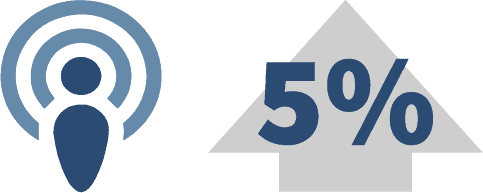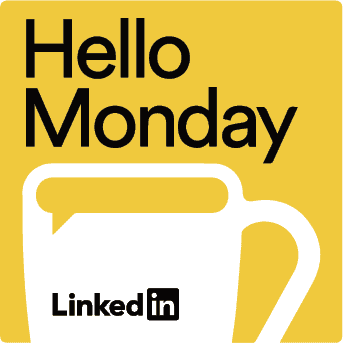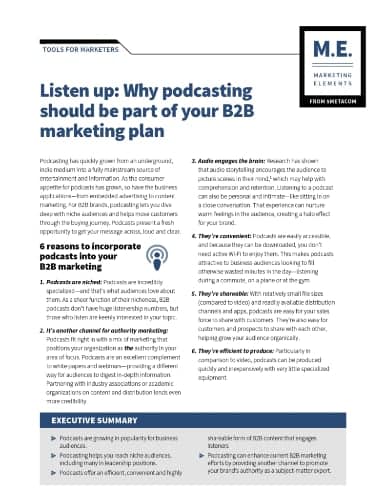Listen up: Why podcasting should be part of your B2B marketing plan
Podcasting has quickly grown from an underground, indie medium into a fully mainstream source of entertainment and information. As the consumer appetite for podcasts has grown, so have the business applications—from embedded advertising to content marketing. For B2B brands, podcasting lets you dive deep with niche audiences and helps move customers through the buying journey. Podcasts present a fresh opportunity to get your message across, loud and clear.
6 reasons to incorporate podcasts into your B2B marketing
1) Podcasts are niched:
Podcasts are incredibly specialized—and that’s what audiences love about them. As a sheer function of their nicheness, B2B podcasts don’t have huge listenership numbers, but those who listen are keenly interested in your topic.
2) It’s another channel for authority marketing:
Podcasts fit right in with a mix of marketing that positions your organization as the authority in your area of focus. Podcasts are an excellent complement to white papers and webinars—providing a different way for audiences to digest in-depth information. Partnering with industry associations or academic organizations on content and distribution lends even more credibility.
3) Audio engages the brain:
Research has shown that audio storytelling encourages the audience to picture scenes in their mind,¹ which may help with comprehension and retention. Listening to a podcast can also be personal and intimate—like sitting in on a close conversation. That experience can nurture warm feelings in the audience, creating a halo effect for your brand.
4) They’re convenient:
Podcasts are easily accessible, and because they can be downloaded, you don’t need active Wi-Fi to enjoy them. This makes podcasts attractive to business audiences looking to fill otherwise wasted minutes in the day—listening during a commute, on a plane or at the gym.
5) They’re shareable:
With relatively small file sizes (compared to video) and readily available distribution channels and apps, podcasts are easy for your sales force to share with customers. They’re also easy for customers and prospects to share with each other, helping grow your audience organically.
6) They’re efficient to produce:
Particularly in comparison to video, podcasts can be produced quickly and inexpensively with very little specialized equipment.
EXECUTIVE SUMMARY
- Podcasts are growing in popularity for business audiences.
- Podcasting helps you reach niche audiences, including many in leadership positions.
- Podcasts offer an efficient, convenient and highly shareable form of B2B content that engages listeners.
- Podcasting can enhance current B2B marketing efforts by providing another channel to promote your brand’s authority as a subject-matter expert.
A podcasting primer
If you’re considering adding a podcast to your B2B marketing mix, here are some tips to ensure your podcast reaches the right audience and helps move your customers along the buying journey.
1) Choose the right media partner:
An existing publication/platform that serves your industry can immediately extend your reach beyond visitors to your own website. Think of it like buying an audio advertorial. Podcasting is still finding its feet in B2B, so look for a partner with not only the right reach, but a track record in podcast distribution. Explore other distribution channels as well, such as having your podcast listed on major streaming platforms like Spotify®.
2) Identify topics to feature:
Look for ways to serialize your content so you can build a loyal audience. Figure out your desired frequency and create a plan that looks at least six months out. If you’re going to develop a series (or miniseries), you may be able to produce multiple episodes at a time, creating economies of scale in your production efforts.
3) Decide on your format:
Podcasts come in a variety of shapes and sizes. Do you want to do a long podcast (30 minutes or even an hour), or keep it a bite-sized 10-15 minutes? Do you want a single speaker to expound on a topic, or introduce multiple voices? Will your podcast come to listeners from a studio or from the field?
4) Take the show on the road:
Consider getting your podcast out of the studio/office. Casting from your factory floor, R&D bench or industry trade show creates a sense of place that connects with listeners. Just be ready to handle potential production challenges.
5) Add some entertainment value:
Look for simple ways to keep your podcast fun and help it stand out from the crowd. How about: a lightning round of rapid-fire questions for interviewees in every episode, fielding reports that come right from a special location, or a “hot topics” segment that provides a quick rundown of industry news?
Now hear this:

The percentage of people who listen to podcasts monthly has doubled in the past 5 years.²

Nearly a quarter (22%) of Americans now listen to podcasts weekly, an increase of 5% in just the last year.²

of LinkedIn® members listen to podcasts.³ Among them, 44% are department heads, VPs, owners and c-suite executives.³

of B2B consumers use podcasts to engage with vendors.4

of podcast listeners tune in to learn new things.²
1) Produce it professionally:
Producing a podcast is quicker, simpler and less expensive than many other tactics, especially video, so many companies choose to produce them in-house. However, doing it right does take some planning and the proper equipment.
- Record the right way: Invest in professional recording equipment, particularly microphones. If interviewees need to participate via phone or a web-conferencing app, test connections and audio quality ahead of time. Consider hiring a professional sound engineer or local audio studio to help.
- Pay attention to your setting: Atmospheric sound is great—noise is not. Make sure the sounds around you won’t distract the audience.
- Edit: Podcasts are not a live medium, which lets you edit content liberally. Cut material that strays off topic, and consider adding music (at the open and during transitions) and even include sound effects, if they help tell the story.
2) Market your podcast:
In addition to the marketing tactics available through your media partner, promote your podcast through all of your owned channels, including your sales force. Engage other thought leader partners to expand your reach: Industry associations, universities, foundations and more. They may be very agreeable to the cross-promotional opportunities of participating in your podcast, or helping to market or distribute it.
3) Source guests for interviews:
Search out contributors who bring genuinely valuable information to your audience (and don’t just repeat your sales message). Remember: Your audience is here to learn something.
4) Choose a host:
This may be an individual from your media partner, someone from your organization or a third-party professional moderator. While your host should be competent on the subject matter, they don’t necessarily need to be an expert. Make sure your host is engaging, a good interviewer and skilled at facilitating the conversation to keep it moving and interesting. Nothing will kill your audience’s interest faster than a boring or disjointed host.
5) Structure the conversation:
Prep both your host and interviewee(s) ahead of time to identify the key points you’re looking to draw out. Script the intro and the conclusion. A rehearsal—even just via conference call—is essential to making your podcast run smoothly and helps create comfort and chemistry between your host and interview subjects.
6) Start with a pilot:
If you’re interested in podcasting, but not completely convinced it’s right for you, there’s no need to make a long-term commitment. Consider producing a pilot episode or “limited series” of 3-5 episodes on a targeted topic to see how it works for your business.
What are we listening to?
(A few of our favorite B2B podcasts)
1. Green Building Matters
This podcast brings theoretical concepts to life and pulls in each guest’s personality.
2. Hello Monday
This series from LinkedIn is industry-agnostic, but looks at issues that shape how people experience their work. Insightful, interesting and credible content keeps us tuning in.
- Wen, T. (2015, April 16). Inside the Podcast Brain: Why Do Audio Stories Captivate? The Atlantic. Retrieved from: https://www.theatlantic.com/entertainment/archive/2015/04/podcast-brain-why-do-audio-stories-captivate/389925/.
- Edison Research. (2019, April 5). The Podcast Consumer 2019. Retrieved from: https://www.edisonresearch.com/the-podcast-consumer-2019/.
- Miller, J. (2016, October 12). Who listens to podcasts—and why they matter to marketers. LinkedIn. Retrieved from: https://business.linkedin.com/en-uk/marketing-solutions/blog/posts/B2B-Marketing/2016/Who-listens-to-podcasts-and-why-they-matter-to-marketers.
- Marketo. (2017). The State of Engagement. Retrieved from: https://www.marketo.com/analyst-and-other-reports/the-state-of-engagement/.
Spotify is a registered trademark of Spotify AB.
All trademarks are the property of their respective owners.



